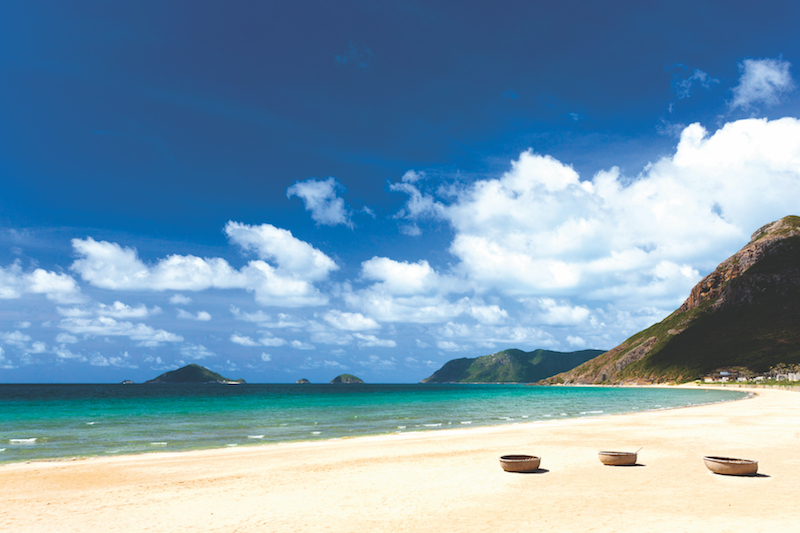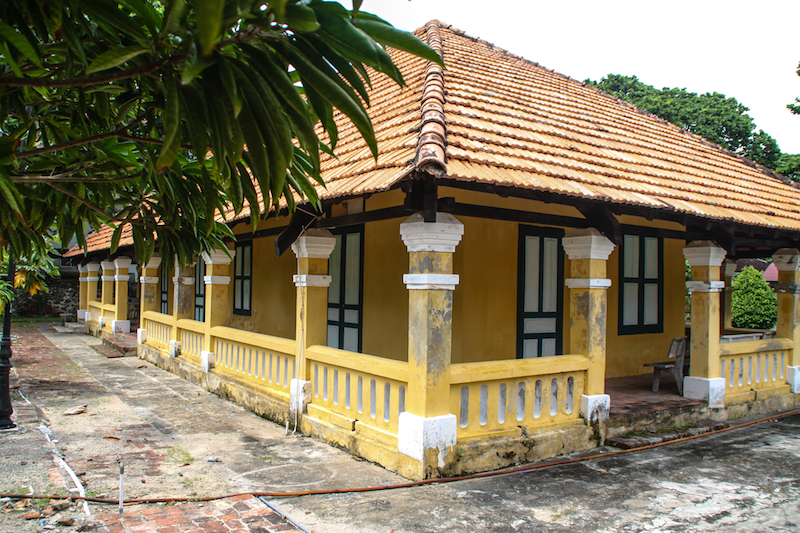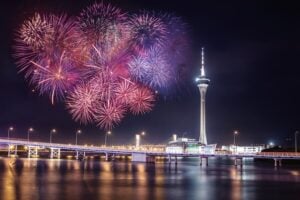From prison island to paradise island, Con Dao’s unspoiled terrain makes it one of the world’s top destinations
“Con Dao is an island of heroes, a great historical monument… It will be the property of the people and an invaluable asset for many generations,” declared General Secretary Le Duan on visiting the island in 1976. It was the year after the island’s infamous 113-year history as a penal colony came to an end, first under French and then South Vietnamese rule.
An archipelago of 16 islands approximately 230 kilometers south of Ho Chi Minh City, Con Dao today refers both to the group of islands as well as its largest and only permanently inhabited island of Con Son. Although there is archaeological evidence of the islands being inhabited as far back as 3,000 years ago and subsequently occupied by seafaring Portuguese, British and French in the 16th to 18th centuries, it’s mainly known to the Vietnamese as an island housing a lone line of national heroes, starting with Lady Phi Yen. Embroiled in a civil war in the late 18th century, her husband, Nguyen Emperor Gia Long sought French support to bolster his cause. Lady Phi Yen objected, hoping to settle the matter without foreign intervention. For her supposed crime of treason, she was banished to Con Dao.
Con Dao’s isolation and harsh but livable conditions made it an ideal place to house prisoners. A century after Phi Yen, the islands became home to the largest prison complex in all of Indochina, beginning with 2,000 mainly political prisoners in 1862. Over the next 113 years, it’s estimated that more than 20,000 lost their lives here out of the many tens of thousands who suffered unspeakable atrocities behind its thick walls, with crystalline blue waters and dense green forests acting as natural jailers. The islanders often say that for every inhabitant, there are three ghosts roaming the hills and beaches of the islands previously known as “hell on earth.
Forty years on, and Con Dao is looks more like heaven than hell. Turtles, dugongs and dolphins swim its warm waters. Approximately 80 percent of the island is national forest, with just one road winding its way down the coast from the airport in the north, past the ultra-lux Six Senses Con Dao, through the center of town, and down to the port where fishing vessels refuel and shelter. The island is shaped like a bear, with its back to the mainland, and the town at its belly. Everything seems to come in two’s here: two banks, two stoplights, two mini-marts on an island that leans more towards catatonic than sleepy.
On a hazy morning, I make the drive back out towards the airport, headed for Dam Trau, one of the island’s prettiest beaches. With only 7,000 residents, half of whom are military personnel, long stretches of road go by before I see another person. Just before the airport, I turn off the road, past the memorial to Prince Cai, Lady Phi Yen’s son, tossed into the sea by his father for making too much noise on the journey. The tar gives way to sand as my motorbike fishtails the rest of the way, finally stopping in front of a beautiful stretch of golden sand beach, anchored by a mass of boulders on one end and thick jungle on the other. Like everywhere else on Con Dao, the beach is blissfully free from mass tourism, with only a few simple huts of bamboo and hastily poured concrete serving up snacks and drinks. Nylon beach chairs and hammocks sway in the breeze and a smattering of tourists down beers and seafood on the otherwise secluded beach. It’s this sense of wild rusticity that beckons people to the island.
“I came here ten years ago with my husband,” says Lua, originally from Bac Lieu in Vietnam’s south. “I heard there was a good opportunity to make a living and that life was better here.” She’s sitting in front of her small house in Zone 1 (out of 10 residential zones on the island), her hands sorting through a pile of squash and cucumbers she’s plucked from her garden. “We were farmers back in Bac Lieu, too, but here we can fetch five times the price. The islanders have a saying: ‘If you’re poor, you eat fish. If you’re rich, you eat vegetables.’”
It wasn’t only economic promise that brought Lua to Con Dao where she’s expecting her first child this month. “It’s quiet here, even compared to country life in Bac Lieu. There’s very little crime. There was news about some guy who snatched a gold necklace at the market, but he wasn’t from around here. He doesn’t know how the island works. With only one main road, where are you going to go? When a crime happens, all they have to do is block the road at both ends, where the planes leave and where the ships leave.”
She’s referring to Ben Dam, the recently built port 10 km south of town, where sailors can hole up for months at a time to wait out bad weather. I make my way along the beautifully rugged coast, sheer cliffs to my right, waves pounding the shore to my left, passing picturesque Bai Nhat (Shy Beach), that only appears during low tide. Almost where the road runs out, I find myself amidst a nondescript grouping of beer joints, karaoke parlors and girlie bars. “Most of the crimes that happen on the island, they happen at the port,” says Phong who works for the island’s one television channel. “It’s sailors getting drunk with nothing to do and getting into fights. Otherwise, the island is practically crime-free.” Con Dao is the kind of place where there are no paid parking lots because you can simply leave your bike on the side of the road, more often than not, with your keys in the ignition.

Everywhere you look on Con Dao, the legacy of the past remains. High up in the mountains stands a watchtower that looks out over the town and the islands in the distance. The place is known as So Ray, a hard labor plantation where prisoners were sent to grow crops in the dense jungle. It’s hard enough scampering up a steep incline over twisted roots and sharp rocks to the top, almost unimaginable for someone malnourished and without shoes. Then there’s the 914 Pier right on the town beach, a testament to the number of lives lost in its construction. Most visible of all are the prison complexes to the north of town, their tiger cages and bleak interiors a sobering reminder of the evils man can inflict on each other. When the island was liberated in 1975, there were 7,448 prisoners freed, with 157 choosing to stay behind to rebuild the island. They were joined by waves of settlers from the mainland, some doing their patriotic duty, others in search of a new life.

Among them were Doan Huu Hoai Minh and his wife Nguyen thi Anh Thu, two artists from Can Tho who arrived in 1984. “I remember the whole island coming down to the pier to meet the ships. We cried like the rain,” remembers Anh Thu, “even if we didn’t know anyone coming off the ships. But because none of us were from the island, every new person felt like family, even if it wasn’t our family.”
“For sure, there were hardships,” says Minh. “We had to ration our rice, but we were never hungry. After work, we’d just walk down to the beach with a lamp and a trident and hunt for crab and fish in the shallow waters. I think that’s how people still view Con Dao, though, as a deserted, forgotten place— like that cartoon with two prisoners in striped uniforms sitting on an island with only a coconut tree between them,” he laughs.
“Our son went to university on the mainland and when his first girlfriend’s parents found out that he was from Con Dao, his mother cried,” Anh Thu remembers with a cackle. “The parents of his second girlfriend threatened to commit suicide if they got married. The thought of their daughter going to live on Con Dao, with nothing to do other than sit and eat turtle soup was worse than death”. Her husband adds: “I remember the tourists in the 80s bringing huge barrels with them. We thought it was wine, but fell down laughing when we discovered they were bringing fresh water because they didn’t think the island had any!”
Even now, 30 plus years on, Con Dao is still regarded by many as a backwards blip on the map. “When I told people that I was moving to Con Dao, they kept asking me if I was running away from a broken heart,” says Thao, a bubbly 20-something from Saigon. “Either that, or they asked if I was coming here to play with the monkeys. But life here is truly peaceful. There’s no traffic, no struggle to compete. In Saigon, people look at what you’re wearing from your shoes all the way up. Here, no one cares.”

Now, slowly though, word is starting to get out about the pristine beauty of the Con Dao Islands, a throwback to what Phu Quoc must have been like 20 years ago. The government has issued long-term plans to develop the island, building up its infrastructure in preparation for mass tourism. Some, like Lua, aren’t particularly worried. “I live in Zone 1, the closest to the airport, closest to the best beach on the island and even though there have been rumors for years about development, I haven’t seen anything yet. I think more tourists would be a good thing because that would mean more people would know about our island.”
Not everyone is so optimistic, though. “I’m both optimistic and pessimistic. I’m happy because that will mean more investment and better lives for people on the island. But I’m worried because if the changes come too quickly, it will destroy what makes the island special. Now, the flights are expensive and limited, and that forms an economic gateway to regulating the number of tourists. If the numbers increase dramatically, that will surely change the community spirit and friendliness of the island,” says a general manager of one the resorts in Con Dao of plans for development.
The studio of husband and wife artists Minh and Anh Thu is filled with paintings of quiet, shady streets and long stretches of deserted beaches. “That’s one of the reasons why we paint,” says Anh Thu, “to document the way life is now because we know it’s going to change. Sure, we’ll see improvements like better roads, schools and hospitals. But we’re afraid of losing the appeal of the island. Con Dao is the pride of the whole nation, not just of the people on this island.”

The sun sets over the town promenade, where soldiers and teens sit on the stone embankment and look out to the sea beyond. A smattering of vendors sell snacks to the small crowd that’s gathered to watch a pick-up game of beach football. Among them is Phuc, 21, who came here for a visit three years ago and never left. “People are different here. They weren’t raised around competition like on the mainland and it shows in their nature. I don’t even miss the big supermarkets or the cinemas. In Saigon, you come home and close the door. You’re making your own prison. Here, it’s a better way of life.” I ask him if he believes that the island is protected by the ghosts of comrades past. He nods. “I pray to them. I pray for peace. For my family and for myself.” Catching his gaze over the spirited game happening below, and out to the glassy sea beyond, I ask him if he’s found it. “Yes, I guess I have.”
Images by James Pham







